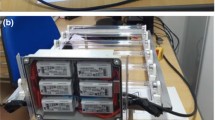Abstract
Due to the current acute problem of combating the SARS-CoV coronavirus, our team has proposed an innovative technology to combat the virus in closed or ventilated rooms. The developed design of ventilation equipment ensures the inactivation of coronavirus by thermal exposure of sufficient duration. The virus is destroyed outside the human body, so sterilization is preventive. Capturing the virus from the airflow and its retention with subsequent disinfection occurs using a finely dispersed catching medium, using the effect of coagulation of the medium vapors, its coalescence, and intense heating. The use of highly efficient heating technology using microwave energy allows sterilizing the virus with minimal energy consumption. Unlike virus disinfection technologies developed in the world using ultraviolet radiation, the technology we offer involves a long-term deactivating thermal effect on the virus, which ensures a high degree of disinfection.
Access this chapter
Tax calculation will be finalised at checkout
Purchases are for personal use only
Similar content being viewed by others
References
Gerchman, Y., Mamane, H., Friedman, N., Mandelboim, M.: UV-LED disinfection of coronavirus: wavelength effect. J. Photochem. Photobiol. B Biol. 212, 112044 (2020). ISSN 1011-1344, https://doi.org/10.1016/j.jphotobiol.2020.112044
Wierzbicki, T., Li, W., Liu, Y., Zhu, J.: Effect of receptors on the resonant and transient harmonic vibrations of Coronavirus. J. Mech. Phys. Solids. 150, 104369 (2021). https://doi.org/10.1016/j.jmps.2021.104369. Epub 2021 Feb 18. PMID: 33623172; PMCID: PMC7890278
Balandin, A., Fonoberov, V.: Vibrational modes of nano-template viruses. J. Biomed. Nanotechnol. 1, 90–95 (2005). https://doi.org/10.1166/jbn.2005.005
Yang, S.C., et al.: Efficient structure resonance energy transfer from microwaves to confined acoustic vibrations in viruses. Sci. Rep. 9(5), 18030 (2015). https://doi.org/10.1038/srep18030.PMID:26647655;PMCID:PMC4673452
Liu, T.-M., et al.: Microwave resonant absorption of viruses through dipolar coupling with confined acoustic vibrations. Appl. Phys. Lett. 94, 043902 (2009). https://doi.org/10.1063/1.3074371
Jiang, Y., et al.: Sub-second heat inactivation of coronavirus using a betacoronavirusmodel. Biotechnol. Bioeng. 118, 2067–2075 (2021). https://doi.org/10.1002/bit.27720
Dobrotvorskiy, S., Dobrovolska, L., Basova, Y., Aleksenko, B.: Diagnostics of uneven heating of the adsorbent by microwave radiation and measures to increase the uniformity of its heating. Periodica Polytech. Chem. Eng. 63(4), 640–649 (2019). https://doi.org/10.3311/PPch.13234
Dobrotvorskiy, S.S., Dobrovolska, L.G., Aleksenko, B.A.: Computer simulation of the process of regenerating the adsorbent using microwave radiation in compressed air dryers. In: Hamrol, A., Ciszak, O., Legutko, S., Jurczyk, M. (eds.) Advances in Manufacturing. LNME, pp. 511–519. Springer, Cham (2018). https://doi.org/10.1007/978-3-319-68619-6_49
Dobrotvorskiy, S., Dobrovolska, L., Aleksenko, B., Basova, Y.: The use of waveguides with internal dissectors in the process of regeneration of industrial adsorbents by means of the energy of ultrahigh-frequency radiation. In: Ivanov, V., et al. (eds.) DSMIE 2018. LNME, pp. 433–442. Springer, Cham (2019). https://doi.org/10.1007/978-3-319-93587-4_45
Dobrotvorskiy, S., Aleksenko, B., Dobrovolska, L., Basova, Y.: Effect of the application of microwave energy on the regeneration of the adsorbent. Acta Polytechnica 58(4), 217–225 (2018). https://doi.org/10.14311/AP.2018.58.0217
Dobrotvorskiy, S., Dobrovolska, L., Basova, Y., Aleksenko, B.: Particulars of adsorbent regeneration with the use of microwave energy. Acta Polytechnica 59(1), 12–23 (2019). https://doi.org/10.14311/AP.2019.59.0012
Kakita, Y., Kashige, N., Murata, K., Kuroiwa, A., Funatsu, M., Watanabe, K.: Inactivation of Lactobacillus bacteriophage PL-1 by microwave irradiation. Microbiol. Immunol. 39(8), 571–576 (1995). https://doi.org/10.1111/j.1348-0421.1995.tb02244.x. PMID: 7494495
Barbora, A., Minnes, R.: Targeted antiviral treatment using non-ionizing radiation therapy for SARS-CoV-2 and viral pandemics preparedness: technique, methods and practical notes for clinical application. PLoS ONE 16(5), e0251780 (2021). https://doi.org/10.1371/journal.pone.0251780
Wang, A., Cheng, N., Liou, Y., Lin, K.: Inactivation of bacteriophage by microwave irradiation. J. Exp. Microbiol. Immunol. 1, 9–18 (2001). Corpus ID: 53380108
Dobrotvorskiy, S., Borys, A., Yepifanov, V., Basova, Y., Dobrovolska, L., Popov, V.: The absorbents nanoporous structures regeneration for industrial dryers by microwave energy. In: Cioboată, D.D. (ed.) ICoRSE 2021. LNNS, vol. 305, pp. 8–22. Springer, Cham (2022). https://doi.org/10.1007/978-3-030-83368-8_2
RF Module User’s Guide. COMSOL© (2018). https://doc.comsol.com/5.4/doc/com.comsol.help.rf/RFModuleUsersGuide.pdf. Accessed 29 Feb 2018
COMSOL User’s Guide. COMSOL© (2018). https://extras.csc.fi/math/comsol/3.4/doc/multiphysics/wwhelp/wwhimpl/js/html/wwhelp.htm?context=multiphysics&file=html_guideintro.5.1.htm. Accessed 22 Aug 2018
Author information
Authors and Affiliations
Corresponding author
Editor information
Editors and Affiliations
Rights and permissions
Copyright information
© 2023 The Author(s), under exclusive license to Springer Nature Switzerland AG
About this paper
Cite this paper
Aleksenko, B.A., Dobrotvorskiy, S., Basova, Y., Sokol, Y., Edl, M., Dobrovolska, L. (2023). Innovative Technology to Combat Sars-Cov Using a Finely Dispersed Catching Medium and Microwave Energy. In: Cioboată, D.D. (eds) International Conference on Reliable Systems Engineering (ICoRSE) - 2022. ICoRSE 2022. Lecture Notes in Networks and Systems, vol 534. Springer, Cham. https://doi.org/10.1007/978-3-031-15944-2_19
Download citation
DOI: https://doi.org/10.1007/978-3-031-15944-2_19
Published:
Publisher Name: Springer, Cham
Print ISBN: 978-3-031-15943-5
Online ISBN: 978-3-031-15944-2
eBook Packages: Intelligent Technologies and RoboticsIntelligent Technologies and Robotics (R0)




